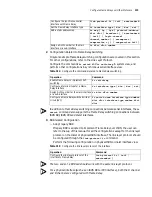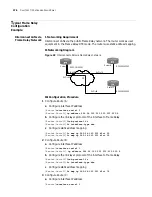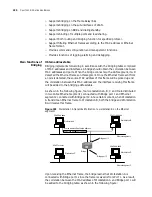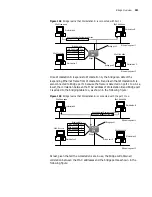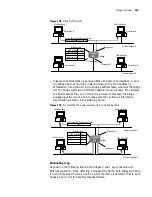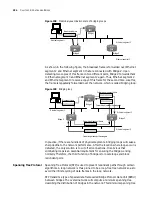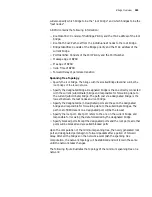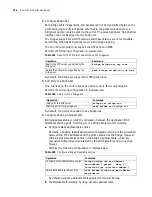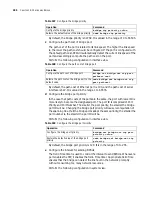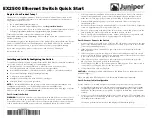
Fault Diagnosis and Troubleshooting of Frame Relay
285
Fault Diagnosis and
Troubleshooting of
Frame Relay
Fault 1: the physical layer in DOWN status.
Troubleshooting:
■
Check whether the physical line is normal.
■
Check whether the opposite equipment runs normally.
Fault 2: the physical layer is already UP, but the link layer protocol is
DOWN.
Troubleshooting:
■
Check whether both local equipment and opposite equipment have been
configured with Frame Relay protocol.
■
If two sets of equipment are directly connected, check the local equipment and
opposite equipment to see whether one end is configured as Frame Relay DTE
interface and the other end as Frame Relay DCE interface.
■
Turn on the monitoring switch for the Frame Relay LMI packet to see whether
the Status Enquiry packets correspond to the Status packet. If not, it indicates
the physical layer data is not receiving or sending correctly. Check the physical
layer. Command
debugging fr lmi-info
is used to turn on the monitoring
switch for Frame Relay LMI information.
Fault 3: link layer protocol is UP, but cannot Ping through the peer.
Troubleshooting:
■
Check whether the link layer protocols of the equipment at both ends are UP.
■
Check whether the equipment at both ends have configured (or created)
correct address mapping for the peer.
■
Check the route table to see whether there is a route to the peer.
Fault 4: After the Frame Relay traffic shaping is enabled on the Frame
Relay interface, the small-sized packets can be pinged, but the large-sized
packets cannot.
Troubleshooting:
■
Configuring a too small committed burst size (CBS) will probably cause this
phenomenon. In common conditions, CBS cannot be less than 12000 bits. If it
is configured too small, the large packets will probably fail to be transmitted.
■
Check the configurations of the Frame Relay class associated with the Frame
Relay interface or the PVCs, and use the fr cbs command to make the CBS
larger.
Fault 4: Frame Relay data cannot be transmitted across ISDN.
Troubleshooting:
■
Check whether BDR has been correctly configured. Read the section of
troubleshooting in
Dial-up
.
■
Use the
debugging dialer event
command to enable BDR event debugging.
If “BDR: Bind failed with more than one profile” is displayed, it means that the
dialer number
command has been configured repeatedly at the receiving
end. In this case, make sure that this command is uniquely configured at the
receiving end.
Summary of Contents for 3036
Page 1: ...http www 3com com 3Com Router Configuration Guide Published March 2004 Part No 10014299 ...
Page 4: ...VPN 615 RELIABILITY 665 QOS 681 DIAL UP 721 ...
Page 6: ...2 ABOUT THIS GUIDE ...
Page 7: ...I GETTING STARTED Chapter 1 3Com Router Introduction Chapter 2 3Com Router User Interface ...
Page 8: ...4 ...
Page 16: ...12 CHAPTER 1 3COM ROUTER INTRODUCTION ...
Page 34: ...30 ...
Page 60: ...56 CHAPTER 3 SYSTEM MANAGEMENT ...
Page 98: ...94 CHAPTER 6 DISPLAY AND DEBUGGING TOOLS ...
Page 110: ...106 ...
Page 114: ...110 CHAPTER 8 INTERFACE CONFIGURATION OVERVIEW ...
Page 158: ...154 CHAPTER 10 CONFIGURING WAN INTERFACE ...
Page 168: ...164 ...
Page 188: ...184 CHAPTER 13 CONFIGURING PPPOE CLIENT ...
Page 192: ...188 CHAPTER 14 CONFIGURING SLIP Router ip route static 0 0 0 0 0 0 0 0 10 110 0 1 ...
Page 248: ...244 CHAPTER 16 CONFIGURING LAPB AND X 25 ...
Page 320: ...316 ...
Page 330: ...326 CHAPTER 20 CONFIGURING IP ADDRESS ...
Page 362: ...358 CHAPTER 21 CONFIGURING IP APPLICATION ...
Page 374: ...370 CHAPTER 23 CONFIGURING IP COUNT ...
Page 406: ...402 CHAPTER 25 CONFIGURING DLSW ...
Page 408: ...404 ...
Page 452: ...448 CHAPTER 29 CONFIGURING OSPF ...
Page 482: ...478 CHAPTER 30 CONFIGURING BGP ...
Page 494: ...490 CHAPTER 31 CONFIGURING IP ROUTING POLICY ...
Page 502: ...498 ...
Page 508: ...504 CHAPTER 33 IP MULTICAST ...
Page 514: ...510 CHAPTER 34 CONFIGURING IGMP ...
Page 526: ...522 CHAPTER 36 CONFIGURING PIM SM ...
Page 528: ...524 ...
Page 532: ...528 CHAPTER 37 CONFIGURING TERMINAL ACCESS SECURITY ...
Page 550: ...546 CHAPTER 38 CONFIGURING AAA AND RADIUS PROTOCOL ...
Page 590: ...586 CHAPTER 40 CONFIGURING IPSEC ...
Page 599: ...IX VPN Chapter 42 Configuring VPN Chapter 43 Configuring L2TP Chapter 44 Configuring GRE ...
Page 600: ...596 ...
Page 638: ...634 CHAPTER 43 CONFIGURING L2TP ...
Page 649: ...X RELIABILITY Chapter 45 Configuring a Standby Center Chapter 46 Configuring VRRP ...
Page 650: ...646 ...
Page 666: ...662 ...
Page 670: ...666 CHAPTER 47 QOS OVERVIEW ...
Page 700: ...696 CHAPTER 49 CONGESTION MANAGEMENT ...
Page 706: ...702 CHAPTER 50 CONGESTION AVOIDANCE ...
Page 707: ...XII DIAL UP Chapter 51 Configuring DCC Chapter 52 Configuring Modem ...
Page 708: ...704 ...
Page 762: ...758 CHAPTER 52 CONFIGURING MODEM ...



